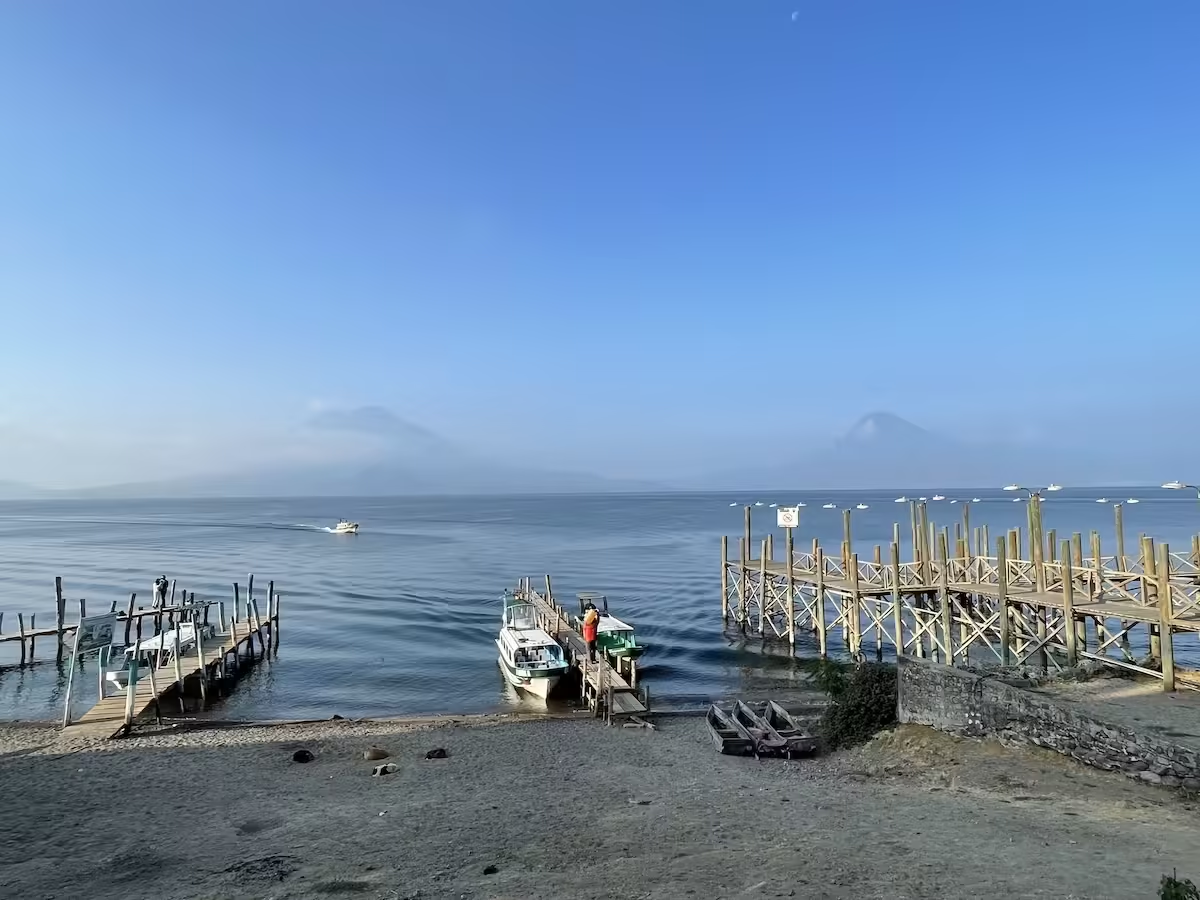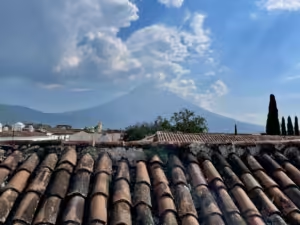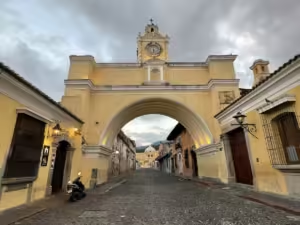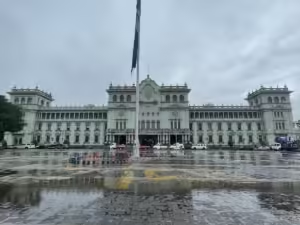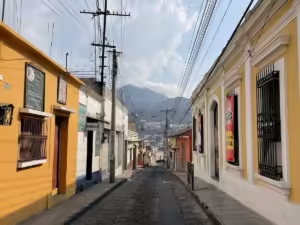There’s a magical place nestled up in the Guatemalan highlands: an azure lake, surrounded by volcanoes and towering cliffs. In 1934, Aldous Huxley called it “too much of a good thing.” Today that beauty has attracted a marauding horde of tourists, ranging from drunken Israeli frat boys to German hippies who’ve swallowed one acid tab too many.
Yet, the lake still retains plenty of local charm. The Mayans who’ve populated the shores for centuries still wash their clothes in the lake water and worship their own saints. Look closely at the steep streets and mural covered walls and you’ll find monuments to the leftist Guerillas who fought to keep the area’s proud indigenous identity. This is Lake Atitlán, Guatemala’s powerhouse travel destination.
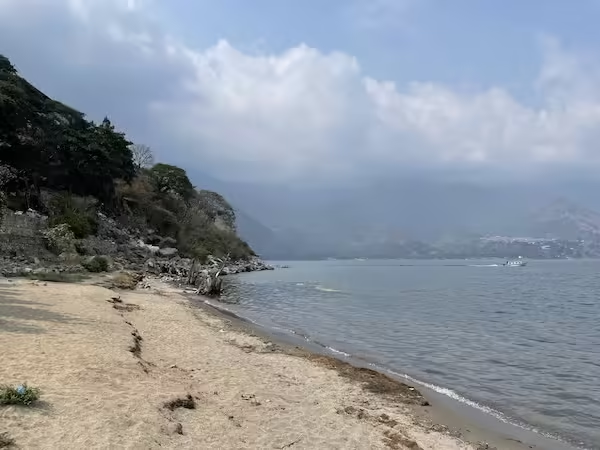
Things to Know Before You Travel to Lake Atitlán
The most important thing to know about traveling to Lake Atitlán is that you need at least a few days to fully appreciate the place. Avoid those whirlwind day tours from Antigua. You’ll spend most of your time on the bus, tossed from village to village with really just enough time to shop for souvenirs.
Lake Atitlán is truly a gorgeous place. Give yourself time to explore the different villages, wander the streets and appreciate the water gently lapping against the shore. Three days is probably the bare minimum, but you could easily spend a week or longer here.
Numerous little villages surround the lake, though most of the tourist infrastructure is concentrated in five of them. Each one of these little towns has a unique feel to it. The locals speak a variety of different Mayan and someone from San Pedro might not be able to understand someone from Panajachel. For tourists with limited knowledge of Mayan linguistics, each town still offers a different vibe and different places to stay and eat.
Luckily, it’s easy to get from one village to another. A network of boats carry visitors and locals from dock to dock around Lago Atitlán. There are set routes that go from different villages to another, sort of like a public bus network, but floating on the water.
The local boat drivers set the prices, which are standardized and sometimes posted on the docks. Those prices are fixed, so don’t be that asshole who throws a hissy fit because you have to spend a few more Quetzals than you wanted to.
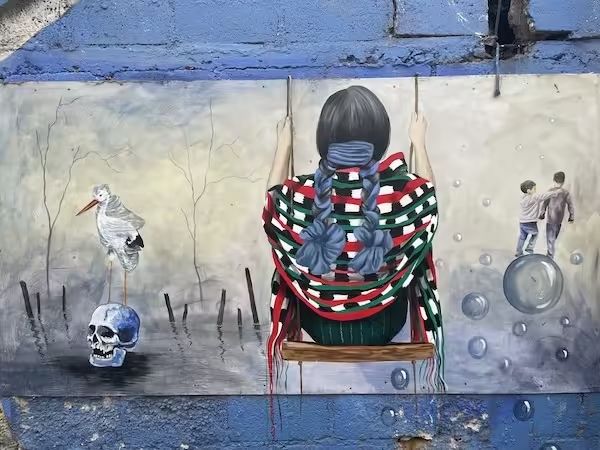
Lago Atitlán’s Rich History and Culture
Lake Atitlán is an ancient place full of rich Mayan culture and traditions. As tourists, we need to appreciate that the locals have opened up their home to us. In exchange, treat those locals with respect. Don’t take pictures or video of anyone without their permission. The local women aren’t wearing those beautiful woven skirts to impress your Tik Tok followers.
In fact, having to deal with annoying tourists snapping photos is probably the least the people of Lake Atitlán have had to deal with. The area was a hotbed of violence during the Guatemalan civil war. The government and paramilitary groups committed numerous atrocities here. These crimes include the massacre of unarmed protesters and the murdering an American priest.
Yet, the most amazing thing about visiting Lago Atitlán is being able to see how these people have survived and even thrived despite this brutal history. Today, numerous villages are semi-autonomous and won’t even allow the Guatemalan army or national police to enter. Brightly painted murals cover the walls of some of the villages, many depicting scenes of resistance, resilience and local pride.
Staying Safe When in Lake Atitlán
Despite, or maybe because of, the lack of official police presence, the villages around Lake Atitlán are incredibly safe. This might actually be the safest area in all of Guatemala. As with anywhere, however, there are still a few things to look out for.
We were warned to avoid hiking between villages solo. Especially don’t try and do the famous and problematically named Indian Nose hike on your own. There have been muggings. Also, none of the trails are particularly well marked, so it would be easy to get lost.
We did have one drunk guy shout “viva Guatemala!” and throw a bag of water at us. It flew wide and splashed the heels of a Mayan woman who was walking nearby. Other than that, the locals are generally pretty friendly, helpful and welcoming.
Finally, be sure to wear a life jacket when boating or kayaking. Most of the public boats will make you put one on, but put one on even if it isn’t mandatory. Better to be safe than sorry.
I have some more thoughts about safety and crime in Central and South America. Read them here: Rethinking Travel Safety and Crime in Latin America
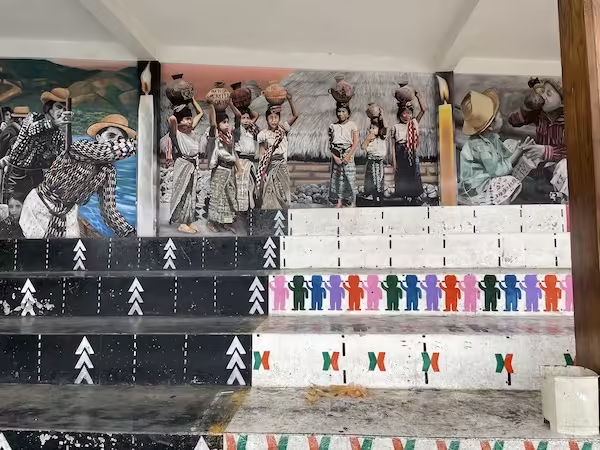
A Guide to the Many Villages of Lake Atitlán
The biggest problem you’re likely to have when traveling to Lago Atitlán is deciding which of the many villages to spend your time in. Despite resting on the shores of the same lake, in the same region of the same country, Lake Atitlán’s villages are surprisingly different. Some are absolutely fantastic. Others are, in my opinion, some of the most annoying places I’ve ever traveled to. Below is a brief travel guide to Lake Atitlan’s villages.
On one of the most fun, but also most stressful, aspects of travel is finding and booking places to stay. These days you have options ranging from dirt cheap hostel dorms to luxurious White Lotus style resorts. Thankfully, the internet is here to make finding accommodation easier.
Hostelworld is the go to app for finding hostels. For everything else, there’s Booking.com. If you book through either of the previous links, I’ll gain a small commission at no extra cost to you.
Panajachel: The Tourist Hub of Atitlán
Most travelers, bloggers and backpackers hate Panajachel, often shortened to “Pana.” This village on the far end of the lake is the king of Lake Atitlán tourism. A seemingly infinite horde of souvenir stalls line the main streets and crowds of touts descend on each incoming bus to hawk tours. By description alone, Panajachel felt like the sort of place I would hate.
However, by scratching a little below the surface, I discovered a surprisingly charming little town. The tourist shops fade away pretty quickly once you leave the main drag, leaving an amiable, if not particularly picturesque, glimpse into daily Guatemalan life.
And even the tourist stuff here isn’t so bad. The town is situated nicely between other, less touristy, indigenous villages as well as an off the beaten path nature reserve. Plenty of options means you can use it as a good base for exploring all that Lago Atitlán has to offer.
The tourism that does exist in the town actually seems to be geared more towards Guatemalans than foreigners. There’s something appealing to me about hanging out in a spot where the locals like to hang out. Embrace the touristy nature of Panajachel and vacation like a real Guatemalan.
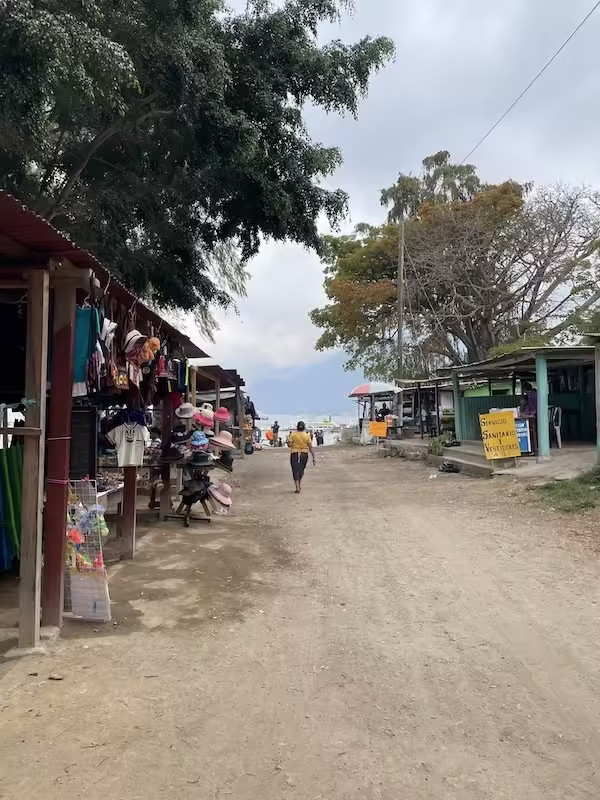
Santiago: An Easily Accessible Look into Modern Mayan Culture
Santiago is Lago Atitlán’s biggest town. It’s also one of the villages that’s managed to not only hold on to its indigenous roots, but to turn those roots into a tourist attraction. That sounds horrible and exploitative, but in reality, it was one of the most interesting things we did in Lake Atitlán.
The town of Santiago itself isn’t going to win any beauty contests. Its buildings are mostly ugly cement blocks and the streets are a chaotic mess. However, this is a living, breathing Mayan community. The best way to discover the cultural beauty that lies below the surface is with a guide.
Tuk Tuk drivers (those ubiquitous three wheeled vehicles that zoom through the developing world) offer tours and will meet you at the boat dock. For around 200 Quetzals, the driver will take you through Santiago’s highlights. You get to see women washing clothes in the lake, a memorial to peaceful protesters who were massacred in 1990 and the church where the aforementioned murdered American priest sermonized. You’ll also visit a textile workshop and get some background information on the meaning behind those gorgeous clothes you see the local women wearing.
The Mystical Maximón
Most interestingly, you also have the chance to visit Maximón. Centuries of intermixing between Catholicism and Mayan religion has produced a syncretic belief system that’s incredibly fascinating. Maximón is a great example of this historical and spiritual mixing.
Maximón, also known as Saint Simon, is a trickster deity that local people pray to for protection. He’s considered a combination of various Mayan, Spanish and biblical figures, both mythological and historical. In Santiago, Maximón is represented as a wooden statue of a man in a wide brimmed hat and decked out with colorful scarves.
Each year, during Semana Santa, the figure of Maximón is paraded through the streets. He resides in a different home each year, and for that year the household is expected to open their doors to worshipers and tourists alike. Locals visit the home to make offerings of rum, tobacco and money, in exchange for Maximón’s protection. We were lucky enough to witness an offering of rum. It was an amazing glimpse into the spiritual life of the modern Maya.
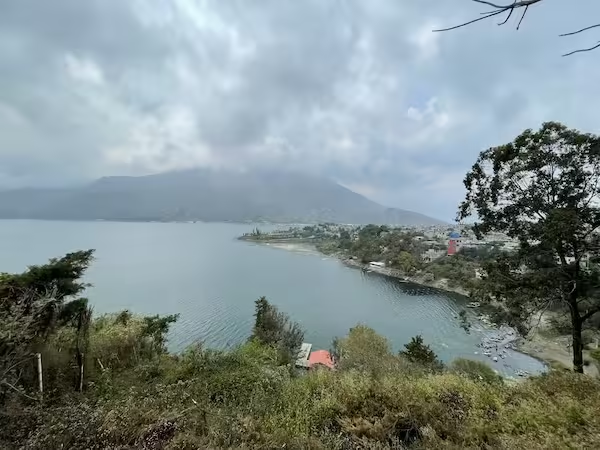
Santa Catarina: The Blue Village of Lake Atitlán
You likely won’t be able to witness any rituals, but Santa Catarina is another modern Mayan village. It’s far less touristy than the other lakeside towns, and much more photogenic than Panajachel or Santiago.
You see, Santa Catarina is famous for its blue houses. Almost every building in town is painted bright blue and decorated in various indigenous motifs. There is a small square and some basic tourist shops, but overall, this is a place where local people go about their lives with relative ambivalence towards tourists.
That’s not to say people aren’t friendly. And when school lets out, the town square gets flooded with dozens of children who seem to take over. There isn’t much to do in Santa Catarina besides wander around, and that’s the whole point. The village is an easy day trip from Panajachel.
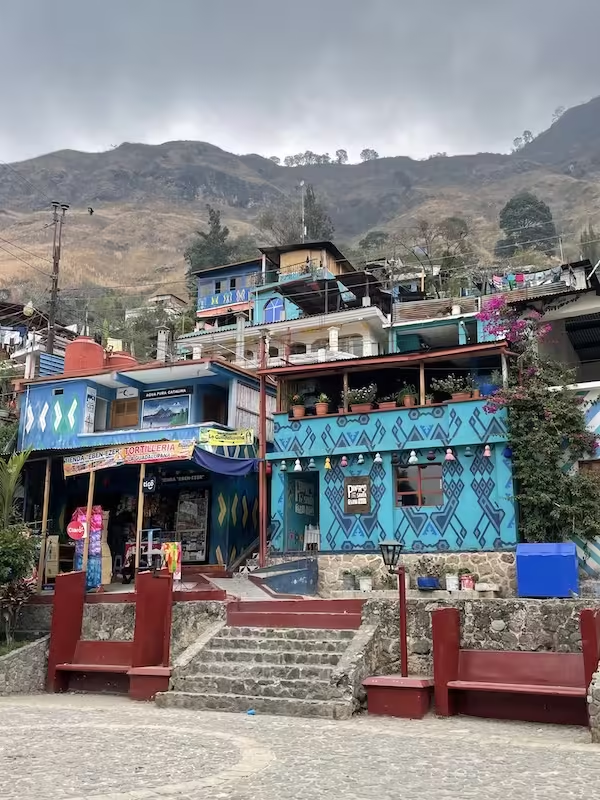
San Pedro La Laguna: The Backpacker Party Town with a Secret
To be honest, I kind of hated San Pedro at first. Stepping off the dock, it feels like the whole town was built just so that 20-year-old European backpackers could have a place to party. The restaurants are overpriced and serve food from everywhere in the world except Guatemala. The streets are crammed with conquering hordes of loud, drunken tourists. The bars blast music until late at night and the only locals you’ll see seem to be there trying to sell tour packages or drugs.
We even stayed outside of town in order to avoid the noise. Or to try to, anyway. It turns out sound carries very well across water, and the loud thumping EDM and shouting of inebriated Israelis gushed directly into our window. It was awful.
That is, until we walked up the hill.
Merely walking up the hill away from the shore in San Pedro brings you into another world. The bars and tour agencies are replaced by local homes and businesses, often painted with colorful street art. The vibrant municipal buildings are covered with radical left-wing murals and there’s music or a celebration at night. There’s also stalls full of amazing Guatemalan street food.
I don’t think I’ve ever been anywhere where the difference between the tourist and local districts was so stark. All it took was a steep walk and some sore calf muscles to escape the tourist ghetto and experience the real magic of Lake Atitlán culture.
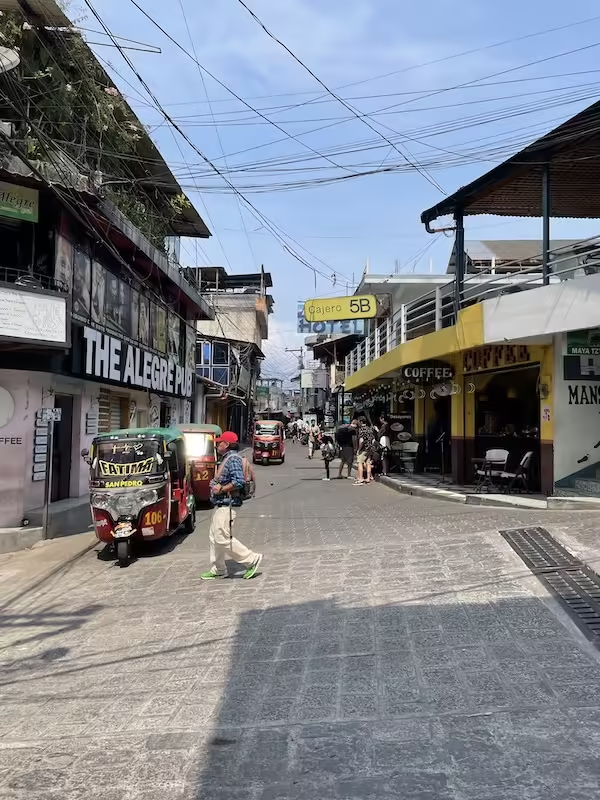
Santa Cruz: the Gentrified Village that Feels Made for Instagram
Santa Cruz is just a short boat ride away from San Pedro. The town itself is very pretty. Perhaps the prettiest town around Lago Atitlán. It’s the kind of place with umbrellas hanging above the streets, walls full of murals and sidewalks done up in tiled mosaics. The village is a magnet for amateur photographers who travel in order to beef up their Instagram accounts.
I found it quite pleasant, but to be honest a bit over priced and sterile. The charm feels very curated and unauthentic. Everything feels geared towards tourists and travel photography, and there’s scant evidence of any local life.
On the other hand, there was a very good ice cream place near the dock. There are some overpriced places to stay in Santa Cruz, or you can make an easy afternoon trip from San Pedro La Laguna.
San Marcos: A Hippie Cesspool
If I had to think of my own personal vision of hell, it very well might be San Marcos. I’ve never been much for the capitalistic wellness marketing of modern hippies. San Marcos only made this feeling worse.
Very little in San Marcos has anything to do with Guatemala. The stores and restaurants appear to be owned by foreign expats and all the signs are in English. There are vegan cafes, yoga studios, crystal workshops and ayahuasca ceremonies. The Mayans never did ayahuasca and they certainly didn’t do yoga. Yet, the whole vibe of San Marcos seems to be trying to sell its snake oil as being somehow connected with Mayan spirituality.
There are a lot of travelers who come to San Marcos and Lake Atitlán to try and find themselves. There’s a whole cabal of pseudo-spiritual wellness entrepreneurs who’ve settled in San Marcos to profit off of those lost souls. They also take advantage of Guatemala’s relatively cheap property and cheap labor costs.
The whole thing felt dirty and exploitative. I hated it. I do not recommend going to San Marcos.
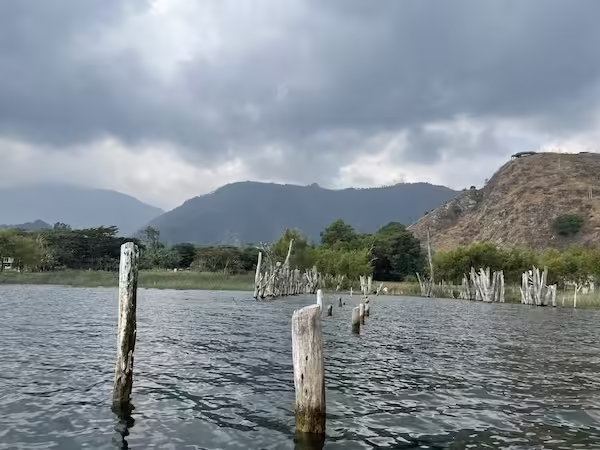
The Best Things to Do around Lake Atitlán
Luckily, there are plenty of things to do around Lake Atitlán that don’t involve wandering around in a drunken or ayahuasca induced haze. You can have a lot of fun wandering around the villages (not San Marcos) exploring side streets and soaking in the local culture. It’s generally pretty easy to base yourself in one village and utilize the boat transportation system to see the others.
For those anxious control freaks who absolutely need to plan everything in advance: may I suggest Get Your Guide for booking tours? They’re generally cheaper than online alternatives and offer a wide range of activities. If you book through the following link, I’ll get a small commission at no cost to you and you’ll gain the satisfaction of supporting an independent travel blog. Click here to explore tours in Guatemala.
The Santiago Tuk Tuk Tour
As I said in my description of Santiago, this standard tour is easy to book and was probably my favorite thing to do around Lago Atitlán. Just go up to any one of the tuk tuk drivers who will come and meet your boat. The driver will take you around the town of Santiago and introduce you to local Mayan textiles and the local deity of Maximón. It really is a great way to experience a taste of the local culture and get a sense of Mayan spirituality. Absolutely fascinating and a must do when you travel to Lake Atitlán.
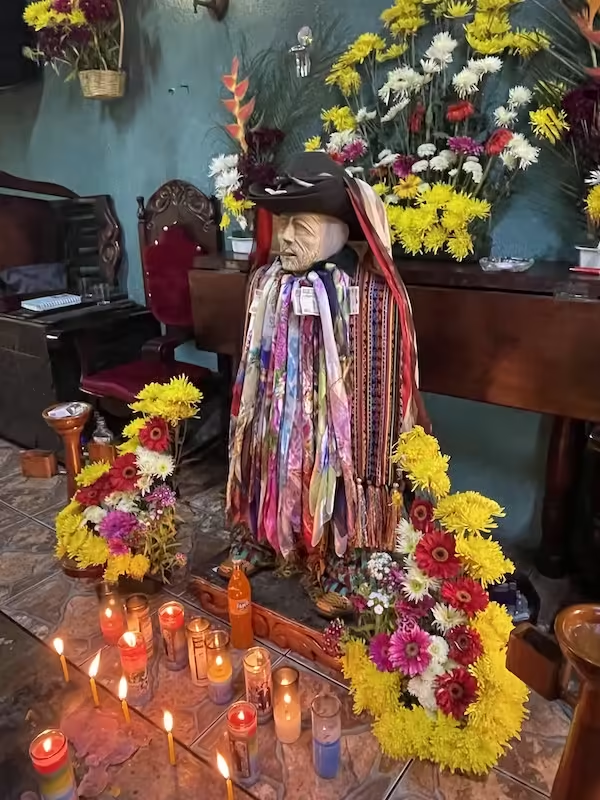
Kayak on the Lake
It would be a shame to come to one of the most beautiful lakes in the world and not get out on it. Most villages have at least one kayak rental shop, and prices were reasonable. Kayaking is a great way to get out on the water and admire the surrounding volcanoes and lakeshore. It’s also surprisingly off the beaten path. We were the only ones out on the water when we kayaked. I have no idea why. Kayaking was easily one of the best things to do in Lake Atitlán.
Reserva Natural Atitlán
Who knew there was a nature reserve super close to Panajachel? The Reserva Natural Atitlán has a small network of trails that scale the hills and cozy up to the lakeshore. You can see all sorts of local tropical birds, as well as spider monkeys and coatis. There’s a lovely butterfly enclosure, too. The trails didn’t seem too strenuous, though there were a few that were a little steep. The reserve also offers zip lining if you’re into that sort of thing. It’s a beautiful place and surprisingly not super crowded.
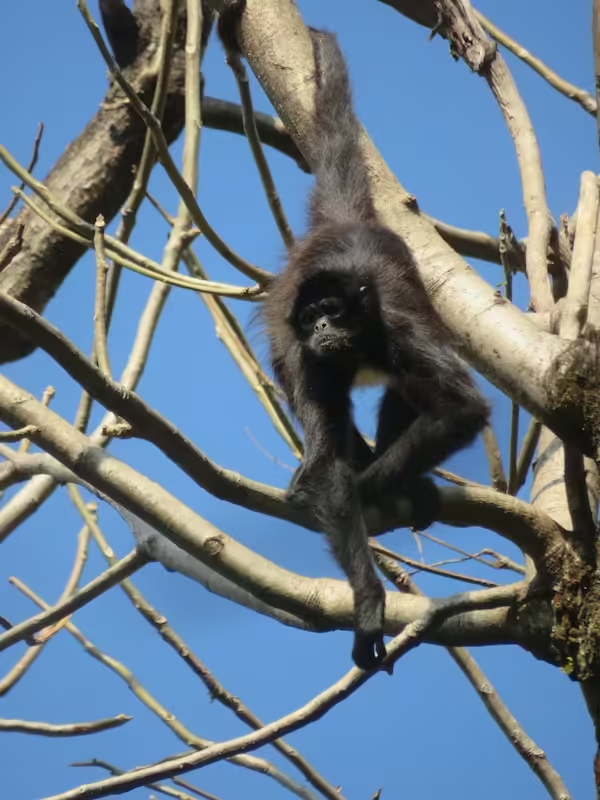
Is the Indian Nose Hike Worth it?
Most travel guides and blog posts list the Indian Nose hike, or “Rostro Maya” if you don’t want to be racist, as one of the top things to do in Lake Atitlán. It’s easy to arrange a tour in San Pedro La Laguna, and the hike itself is pretty easy. To be honest, I did the hike and was a little underwhelmed.
We woke up super early in the morning to cram into a van with about 20 other tourists, some still drunk from the night before. After clambering up to the viewpoint area in the dark, we had coffee and waited for the sun to rise. A couple other tour groups arrived as we waited, so in the end there were about 30 of us crammed together on the hilltop. When the sun finally rose, it revealed a thick wall of clouds and not much else.
Maybe it was just the time of year we went (early March), but I’m not going to rush out and do it again. There are plenty of other things to do when you travel to Lake Attilán. Also, it’s the 21st century, you’d think we could come up with a better name than “Indian Nose.” I guess the Spanish “Rostro Maya” is a bit more woke.
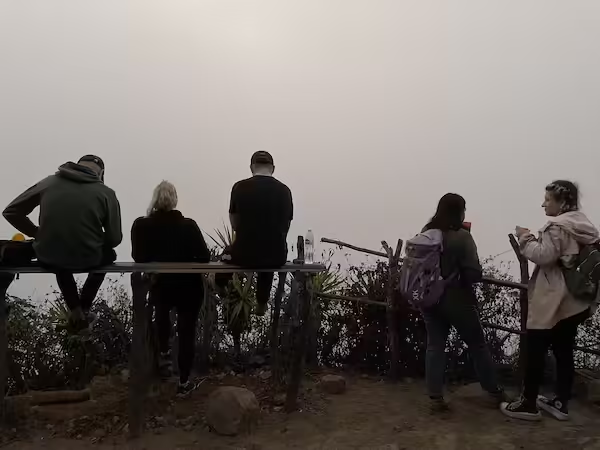
Whatever you call it, Lake Atitlán is one of Guatemala’s top travel destinations for a reason. The lake itself is absolutely stunning. The surrounding villages are varied, and offer plenty of opportunities to experience living, breathing, Mayan culture. Lago Atitlán is one of those rare places that became a tourist hotspot without losing its soul. Let’s hope it stays that way.
Looking for more places to visit in Guatemala? Go to Guatemala: A Travel Guide Without the Tourist Traps
Useful Websites for Traveling Guatemala
As much as we might long for the days when you could show up to a town with nothing more than a beat-up guidebook and a sense of adventure, today much of traveling involves being glued to our phones making bookings. I’ve compiled some helpful apps and websites below that at least help make those bookings more convenient so you can spend less time staring at your phone and more time exploring at your surroundings. Some of these sites are affiliate links that give me a small commission at no cost to you if you chose to book through them. All of them are sites I’ve used personally and have no problem recommending.
Just be sure to do your due diligence as much as possible. Only hire local guides and try as much as possible to stay in locally owned hotels and hostels so that your hard earned travel dollars actually go to support the local economies of the places you visit.
Booking.com is basically the world’s only hotel booking website. They have hotels, guesthouses and vacation rentals all over Guatemala.
Hostelworld is the go-to site for booking hostels. If dorm rooms and shared bathrooms are your thing, you’ll find hostels all over Guatemala.
Get Your Guide offers tours and activities all around the world. Unlike some other sites and apps that do the same thing, you can actually find some reasonably priced deals here.

